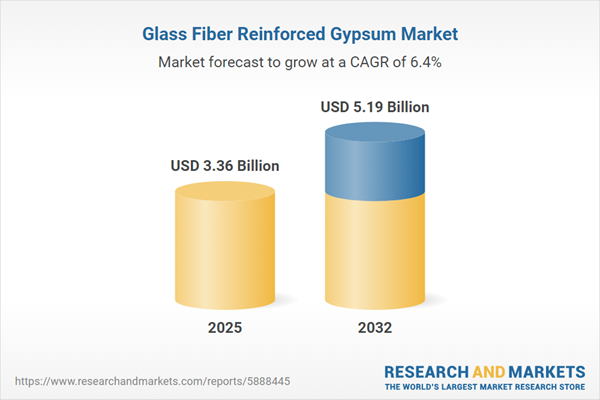Speak directly to the analyst to clarify any post sales queries you may have.
The glass fiber reinforced gypsum market empowers executive teams to sharpen compliance, sustainability, and operational efficiency strategies in the face of evolving construction and regulatory requirements. As developments in project portfolios reveal its potential, this advanced material supports future-ready building outcomes.
Market Snapshot: Glass Fiber Reinforced Gypsum Market Trends
Globally, the glass fiber reinforced gypsum (GFRG) market is experiencing significant transformation, fueled by intensified demand for lightweight, durable, and fire-resistant construction solutions. Ambitious building projects increasingly select GFRG for its performance and ability to simplify compliance with contemporary safety guidelines. Trends shaping the sector include a strong focus on modular development and environmentally responsible materials, reinforcing GFRG's growing acceptance across commercial, industrial, and residential segments. For leadership teams, these movements signal opportunities to enhance project differentiation, deliver on quality benchmarks, and maintain streamlined regulatory alignment as construction practices evolve.
Scope & Segmentation in the Glass Fiber Reinforced Gypsum Market
Targeted segmentation in the glass fiber reinforced gypsum market equips procurement and executive leaders to understand specific project opportunities, mitigate uncertainty, and strengthen decision-making throughout every phase. Key categories include:
- Application Type: GFRG demonstrates versatility across a spectrum of building contexts, such as commercial offices, residential complexes, hospitality centers, retail spaces, manufacturing facilities, infrastructure initiatives, and custom residential settings, each with their own requirements for flexibility and compliance.
- Product Forms: Offerings include fire-rated panels, standard wall boards, integrated wall and ceiling elements, decorative details, acoustically engineered tiles, and customized feature panels. This variety allows organizations to address regulatory needs, aesthetic objectives, and adapts to diverse architectural visions.
- Distribution Channels: Options for procurement range from direct partnerships with manufacturers and engagement with wholesale distributors, to leveraging specialized e-commerce solutions and global supply frameworks. Multiple channels facilitate uninterrupted access and help uphold project delivery commitments.
- End-User Groups: Architects, construction contractors, trained installers, and do-it-yourself practitioners value GFRG for its ease-of-installation, reliable regulatory outcomes, and capacity to support swift and systematic construction processes.
- Regional Coverage: The market’s approach varies across distinct regions—namely the Americas, Europe, Middle East, Africa, and Asia-Pacific—reflecting localized compliance practices, preferred design frameworks, and operational needs that shape adoption curves and delivery methods.
- Key Technologies: Recent innovations encompass improved high-strength gypsum compounds, advanced surface coatings, seamless compatibility with Building Information Modeling (BIM) software, and solutions supporting prefabrication. These improvements enable efficiency in installation, enhance material use, and reduce environmental impacts.
Key Takeaways for Senior Decision-Makers
- Organizations are leveraging GFRG to update construction methodologies, achieve distinctive design results, and meet rigorous fire and acoustic standards, thereby reducing risk of project interruptions.
- Sourcing GFRG with higher recycled content provides a practical path for organizations seeking to align procurement with environmental goals and simplified compliance, while remaining cost-effective.
- The integration of BIM-compatible offerings and online procurement platforms is improving planning accuracy and refining resource allocation, translating to better project precision and fewer operational setbacks.
- Prefabricated GFRG modules allow for efficient use of labor and simplified construction site coordination, supporting both small-scale and large-scale project demands.
- Collaborative sourcing strategies between procurement divisions and supply partners strengthen stability and responsiveness, even as market dynamics or supply constraints emerge.
- Investment in research and development ensures that GFRG technologies remain responsive to shifts in technical regulations and evolving client requirements across different regions and project types.
Tariff Impact Analysis
Recent tariffs on glass fiber reinforced gypsum products in the United States have driven organizations to re-examine their sourcing strategies. As a result, many are broadening supplier networks and strengthening domestic partnerships to support stability in procurement costs and delivery timelines. This shift is encouraging further investment in advanced supply chain technologies, adding resilience and dependability essential for ongoing business growth and adaptability.
Methodology & Data Sources
This assessment integrates interviews with industry experts, reviews of technical publications, regulatory analysis, and patent research. Each finding is validated with current trade and customs records, ensuring actionable insights for procurement and executive teams.
Why This Report Matters to You
- Senior leadership benefits from strategic, actionable analysis to anticipate evolving market shifts and maintain agility in planning and execution.
- Detailed segmentation guides the development of reliable supplier relationships and enhances project management in line with changing compliance pressures.
- The report supports organizations in proactively tackling market challenges, fostering constructive partnerships, and delivering consistent results in dynamic conditions.
Conclusion
This report enables business leaders to align sourcing, compliance, and operations, supporting reliable delivery and stable long-term performance in the glass fiber reinforced gypsum market.
Additional Product Information:
- Purchase of this report includes 1 year online access with quarterly updates.
- This report can be updated on request. Please contact our Customer Experience team using the Ask a Question widget on our website.
Table of Contents
3. Executive Summary
4. Market Overview
7. Cumulative Impact of Artificial Intelligence 2025
Companies Mentioned
The companies profiled in this Glass Fiber Reinforced Gypsum market report include:- Compagnie de Saint-Gobain SA
- Knauf Gips KG
- USG Corporation
- Etex NV
- Georgia-Pacific Gypsum LLC
- Eagle Materials, Inc.
- National Gypsum Company
- American Gypsum Company
- BNBM International Investment Company Limited
- Hefei Huayi Group Co., Ltd.
Table Information
| Report Attribute | Details |
|---|---|
| No. of Pages | 189 |
| Published | November 2025 |
| Forecast Period | 2025 - 2032 |
| Estimated Market Value ( USD | $ 3.36 Billion |
| Forecasted Market Value ( USD | $ 5.19 Billion |
| Compound Annual Growth Rate | 6.3% |
| Regions Covered | Global |
| No. of Companies Mentioned | 11 |









